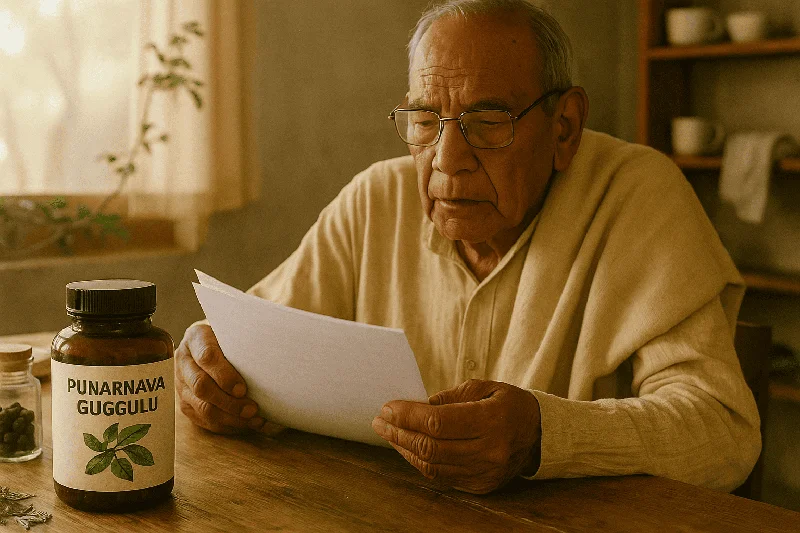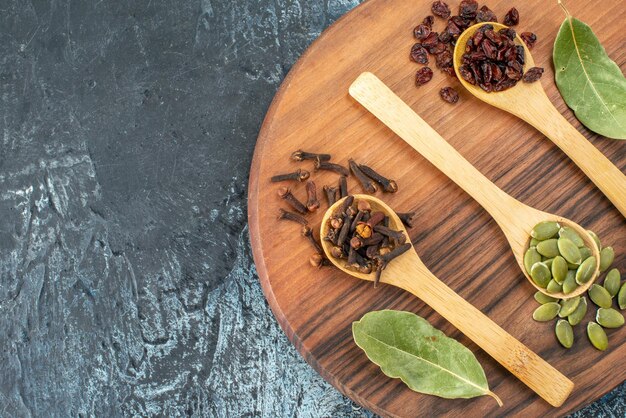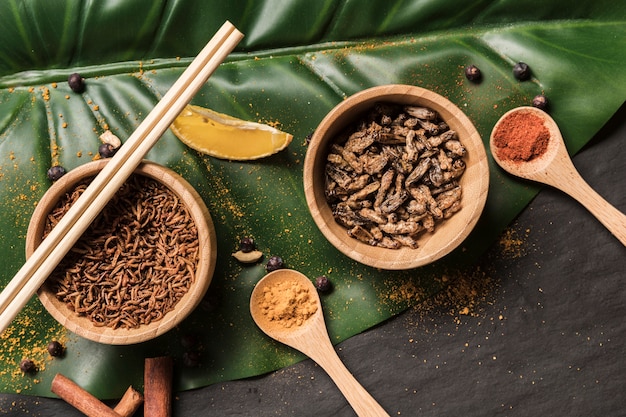Ask Ayurvedic doctor a question and get a consultation online on the problem of your concern in a free or paid mode. More than 2,000 experienced doctors work and wait for your questions on our site and help users to solve their health problems every day.
Shop Now in Our Store
Punarnava Guggulu Uses: Benefits, Research, and Precautions

The world of traditional Ayurvedic medicine is teeming with time-honored formulations that many people use to address an array of health issues. One such polyherbal blend is Punarnava Guggulu, often praised for its potential to support joint health, metabolic balance, and more. If you’ve been curious about the uses of Punarnava Guggulu, the latest scientific studies, or the best ways to incorporate it into your health regimen, this comprehensive guide covers all you need to know.
In this article, we will explore:
- The basics of Punarnava Guggulu and its Ayurvedic origins
- The primary uses and purported benefits, including evidence-based findings
- Research insights, including references to peer-reviewed studies
- Practical advice on dosage, safety, and potential side effects
- Common questions people ask about Punarnava Guggulu
Before we proceed, please note: This article is for informational purposes only and does not substitute professional medical guidance. Always consult a qualified healthcare provider before starting any new supplement.
Understanding Punarnava Guggulu
What Is Punarnava?
Punarnava (Boerhavia diffusa) is a well-known herb in Ayurveda, recognized for its potential diuretic and anti-inflammatory properties. The term “Punarnava” translates to “renewed” or “brought back to life,” reflecting the herb’s capacity to rejuvenate and revitalize. Historically, Punarnava has been used in formulations aimed at supporting kidney function, fluid balance, and joint health.
Clinical interest in Punarnava has grown over the past decade, with researchers studying its phytochemical components—such as alkaloids, flavonoids, and glycosides—and their impacts on physiological functions. A study published in the Journal of Ethnopharmacology suggests that Punarnava may show promising anti-inflammatory and antioxidant activities [1].
What Is Guggulu?
“Guggulu” typically refers to the resin derived from the Commiphora mukul tree. In Ayurveda, Guggulu is revered for its ability to enhance metabolism, support healthy cholesterol levels already within the normal range, and promote joint comfort. Guggulu resin is a cornerstone of many Ayurvedic combinations, including the popular “Triphala Guggulu” and “Yogaraj Guggulu,” each aiming to support different aspects of health.
Modern research validates some of Guggulu’s benefits. For instance, a meta-analysis in the journal Phytotherapy Research highlighted Guggulsterones—active compounds in Guggulu resin—for their potential anti-inflammatory and lipid-lowering properties [2].
Punarnava Guggulu: A Polyherbal Powerhouse
When Punarnava is combined with Guggulu and other Ayurvedic botanicals (like ginger, black pepper, and Indian gooseberry), you get Punarnava Guggulu, a synergistic blend that allegedly delivers multiple benefits. According to classical Ayurvedic texts, Punarnava Guggulu is commonly indicated for:
- Supporting kidney and urinary tract health
- Maintaining fluid balance in the body
- Promoting comfortable movement of joints and muscles
- Assisting in healthy weight management
However, these uses are based primarily on traditional Ayurvedic principles. Let’s dive into the scientific research that supports (or questions) these claims.
Key Evidence and Modern Research
Supports Joint and Muscle Comfort
Traditionally, Punarnava Guggulu has been used to ease discomfort related to joints, muscles, and connective tissues. One reason for this may be the blend’s high content of bioactive compounds with anti-inflammatory properties.
- Research Insight: A 2015 study in the International Journal of Basic & Clinical Pharmacology examined the effectiveness of Punarnava in reducing inflammatory markers. Although the study did not specifically focus on Punarnava Guggulu, it indicated that Punarnava extracts had notable anti-inflammatory effects [3]. Guggulu, on the other hand, is already recognized for its potential to modulate inflammatory pathways [2].
The combination of these herbal components could potentially offer synergistic action, making Punarnava Guggulu a popular choice in Ayurvedic therapies aimed at joint health.
May Assist in Fluid Balance
Punarnava has a long history of use for supporting healthy fluid balance, including kidney and urinary function. This is why Ayurvedic practitioners sometimes recommend Punarnava Guggulu to people experiencing water retention or edema-like symptoms.
- Research Insight: A study available in the Journal of Ayurveda and Integrative Medicine [4] points to Punarnava’s diuretic effects, noting a reduction in fluid accumulation in experimental models. While more human trials are needed to confirm these findings, such preliminary data lend support to Ayurvedic claims.
Potential Weight Management Benefits
Punarnava Guggulu is sometimes marketed for “weight loss.” While the direct scientific evidence is still emerging, certain individual components have shown promise:
- Guggulsterones: Found in Guggulu, these compounds have been investigated for their role in lipid metabolism. A 2011 review in the journal BioMed Research International observed that Guggulsterones might support healthy cholesterol levels [5]. However, evidence for direct weight reduction is inconclusive.
- Punarnava Extract: May help regulate fluid retention, which could indirectly influence weight management if water retention is an issue.
It’s important to keep your expectations grounded. Weight management involves a holistic approach—diet, exercise, and lifestyle factors all play crucial roles.
Digestive and Metabolic Support
Ayurveda suggests that Punarnava Guggulu may help maintain a healthy digestive “agni,” or metabolic fire. Components like ginger and black pepper (often included in Punarnava Guggulu formulations) can aid in digestion and nutrient absorption.
- Research Insight: Spices such as ginger and black pepper are clinically proven to have thermogenic and digestion-supporting properties [6]. Although more specific, large-scale human trials focusing on Punarnava Guggulu are needed, existing data on its constituent herbs is promising.
Safety, Dosage, and Precautions
Recommended Dosage
In traditional Ayurvedic practice, Punarnava Guggulu is often administered in powder form or as tablets. Typical doses range from 1 to 2 tablets twice daily, or about 1–3 grams of the powdered formulation per day, taken with warm water. However, the exact dosage can vary depending on:
- The specific formulation or brand
- Individual constitution (Prakriti)
- The advice of a qualified Ayurvedic practitioner or healthcare provider
Important: Self-prescribing herbal supplements can lead to unintended side effects. Always consult a healthcare professional for personalized recommendations.
Potential Side Effects and Interactions
Most people tolerate Punarnava Guggulu well when used appropriately. However, side effects are still possible:
- Mild digestive upset, such as gas or acid reflux
- Allergic reactions to any of the constituent herbs
- Interactions with diuretic medications (due to Punarnava’s diuretic properties)
If you’re pregnant, nursing, or taking prescription medications (especially those for liver or kidney conditions), consult a qualified healthcare provider before using Punarnava Guggulu. According to a review in the Journal of Alternative and Complementary Medicine, herbal formulas with Guggulu may interact with drugs that affect lipid metabolism [7].
Quality Control and Sourcing
Ensuring the quality and purity of herbal products is crucial. Look for:
- Reputable Brands: Companies that adhere to Good Manufacturing Practices (GMP).
- Third-Party Testing: Certificates of Analysis (CoA) confirming the absence of heavy metals, microbial contamination, or adulterants.
- Transparent Labeling: Full disclosure of all ingredients and their concentrations.
Consult consumer protection agencies or watch for seals of approval from organizations like the U.S. Pharmacopeia (USP) or NSF International for an added layer of trust.
Practical Tips for Using Punarnava Guggulu
- Start Slowly: If you’re new to herbal supplements, begin with a lower dosage and monitor your body’s response.
- Pair with the Right Diet: An Ayurvedic-friendly diet rich in whole grains, lean protein, vegetables, and spices like turmeric or ginger can complement Punarnava Guggulu’s properties.
- Stay Hydrated: If you’re using Punarnava Guggulu for its diuretic effect, maintain proper hydration to support kidney health.
- Lifestyle Matters: Incorporate mild exercise, adequate rest, and stress-reduction techniques (like yoga or meditation) to enhance the overall efficacy of any Ayurvedic regimen.
- Professional Guidance: Periodic check-ins with an Ayurvedic doctor or integrative medicine specialist can help you optimize results and adjust dosages if needed.
FAQs About Punarnava Guggulu Uses
1. Is Punarnava Guggulu Safe for Long-Term Use?
Generally, when taken at recommended dosages and with the guidance of a healthcare professional, Punarnava Guggulu is considered safe for many individuals. However, the long-term safety profile hasn’t been extensively studied in large clinical trials. If you plan on long-term use, consult your doctor for regular check-ups and blood tests to monitor liver and kidney function.
2. Can Punarnava Guggulu Help With Arthritis?
Ayurvedic texts often recommend Punarnava Guggulu for joint and muscle comfort, including arthritic conditions. Modern studies on Punarnava and Guggulu suggest anti-inflammatory effects. While these findings are encouraging, they do not guarantee that Punarnava Guggulu will work for everyone. Always discuss with a medical professional before starting any regimen for arthritis.
3. How Quickly Will I See Results?
The time frame to notice changes can vary from a few weeks to several months, depending on individual health status, dosage, and lifestyle factors. Remember that herbal supplements generally work more slowly than conventional medications.
4. Can I Take Punarnava Guggulu With Other Ayurvedic Formulas?
Punarnava Guggulu is often combined with other Ayurvedic remedies such as Triphala Guggulu or Shilajit to target multiple issues simultaneously. However, multi-herbal regimens should be tailored by a qualified practitioner to avoid overlapping or excessive dosages of particular ingredients.
5. Do I Need a Prescription?
In many countries, Punarnava Guggulu is classified as a dietary supplement and can be purchased over the counter. Even so, obtaining personalized medical advice ensures safe and targeted usage.
Conclusion: Is Punarnava Guggulu Right for You?
From traditional Ayurvedic texts to emerging modern research, Punarnava Guggulu stands out for its potential to support joint health, fluid balance, and healthy metabolism. While preliminary studies and anecdotal reports are promising, the need for larger, high-quality clinical trials remains. If you’re considering Punarnava Guggulu, consult a healthcare professional to ensure it aligns with your medical history and current treatments.
Ultimately, the best health outcomes often come from a blend of balanced nutrition, proper exercise, mindful living, and a combination of evidence-informed therapies. Punarnava Guggulu could be one piece of that puzzle—provided it’s used wisely and under expert supervision.
Disclaimer
This article is for informational purposes only and is not a substitute for medical advice, diagnosis, or treatment. Always seek the advice of your physician or another qualified health provider with any questions about a medical condition.
References
Research on the anti-inflammatory and antioxidant activity ofBoerhavia diffusain theJournal of Ethnopharmacology Meta-analysis on Guggulu’s properties inPhytotherapy Research Study on Punarnava’s anti-inflammatory potential in theInternational Journal of Basic & Clinical Pharmacology Punarnava diuretic effect in theJournal of Ayurveda and Integrative Medicine Role of Guggulsterones in lipid metabolism inBioMed Research International Thermogenic effect of ginger and black pepper in various clinical trials Herbal-drug interactions with Guggulu inJournal of Alternative and Complementary Medicine
Call to Action
If you’ve found this article helpful, share it on social media or leave a comment below. For more evidence-based insights on Ayurveda and other holistic health practices, subscribe to our newsletter. By staying informed, you can make better decisions for your well-being and explore how Punarnava Guggulu might fit into your holistic health journey.
This article is checked by the current qualified Dr. Harsha Joy and can be considered a reliable source of information for users of the site.



